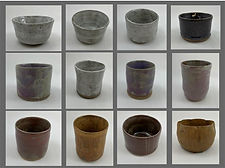Course Title: ART 230 Ceramics II
Term: Fall and Spring
COURSE DESCRIPTION:
Major, Elective credit. Prerequisite: Art 130.
An in-depth course in throwing forms on the potter’s wheel with formalized study of the mixing and application of glazes.
COURSE OBJECTIVES:
-
Students will be able to understand the use of the potter’s wheel for the making of vessel forms.
-
Students will understand the use of the potter’s wheel for the removal of clay to create footed vessel forms.
-
Students will understand how to create handles and attach these handles onto wet vessel forms.
-
Students will understand how to use tools for making similar bowl forms and similar cup forms with the potter’s wheel by employing methods for gauging size and proportion.
-
Students will understand the technical aspects and the making of three different wheel-thrown lid seats and lids specific to their respective lid seats.
-
Students understand how to combine three or more separate wheel-thrown forms and attach together to create a vessel form.
-
Students will be able to evaluate ceramic art critically in an oral format through one-on-one interaction with the instructor and in group critiques.
-
Students will be able to successfully document their ceramic projects in a digital format.
COURSE LEARNING OUTCOMES:
-
Students will produce vessels using the potter’s wheel.
-
Students will properly trim footed vessel forms on the potter’s wheel.
-
Students will create handles and attach them onto wet vessel forms.
-
Students will make a set of similar bowls and a set of similar cups, employing methods and tools for gauging size and proportion.
-
Students will make a vessel form with a specific lid seat and a proper fitting lid.
-
Students will make a vessel form that incorporates three or more separate forms made on the potter’s wheel.
-
Students will participate in one-on-one discussions and oral classroom critiques, with the proper use of visual and technical vocabulary, while demonstrating an awareness of critical thinking relating to clay.
-
Students will successfully document finished work which will be submitted to the professor via Google Drive.
Choose 5 Artists for Inspiration
Create a Google Slides or PowerPoint document to share five ceramic artists (historic or contemporary) whose work inspires you. Be sure to share the artist's name, links to their website or social media accounts, and a few images of their work.
Virtual Studio Visit Reflections
Virtual Studio Visits are used as a means to expose students to contemporary ceramic artists while also reinforcing the importance of a historical perspective on the craft. This is also an intentional opportunity for students to hear ceramicists speak about their work. At assigned intervals, students will select three videos shared via padlet page and respond to reflection questions.
Reflections:
Students are asked to respond to self-critique questions as a written reflection of their work on each assignment after bisque and glaze firings.
Documentation:
Students are required to document all ceramics projects and submit these images at the end of the semester. Additionally, students are expected to document works in progress as required by self-critique assignments.
Studio Projects
Project 1: Wheel
Objective: Learn the basic elements of wheel throwing (centering, opening, pulling up walls) and trimming while gaining confidence throwing cylinders.
-
Project Parameters: As students learn to self-edit they are asked to keep only the best examples of their work to continue through the glazing process. This should be a minimum of 10-15 pieces.


Project 2: Bowls
Objective: Further refine the ability to throw and trim forms while gaining an understanding of how to adjust the basic steps to throw a bowl.
Project Parameters:
-
As students learn to self-edit they are asked to keep only the best examples of their work to continue through the glazing process. This should be a minimum of 10-15 pieces.


Project 3: Developing Surfaces and Forms
Objective: As students build their comfort level with throwing cylinders and bowls, they are asked to explore surface development utilizing the techniques learned in Ceramics I, including texture, Mishima, and Sgraffito.


Project 4: Matching and Mis-Matched Pairs
Objective: Continue skills building to incorporate making forms which (a) match exactly in scale and (b) to make forms which relate to one another through surface treatment.
Project Parameters:
-
At least one pair of matching cylinders.
-
At least one pair of matching bowls.
-
At least one mis-matched pair which relates through surface.
Matching Bowl Samples


Matching Cylinder Samples


Mis-matched Samples


Project 5: Lidded Vessels
Objective: Utilize the skills gained with making matching forms to create lidded vessels. Students will learn three styles of lids/lid seats.
Project Parameters:
-
Create two lidded vessels.
-
Consider the function of the form based on the size of the opening.
-
Develop an understanding of how to glaze lids which will be fired in place.


Project 6: Combined Forms
Objective: Explore the possibilities to develop a large form by combining multiple forms.
Project Parameters:
-
Students must combine at least 3 forms.
-
At least two of these forms must be thrown on the wheel.


